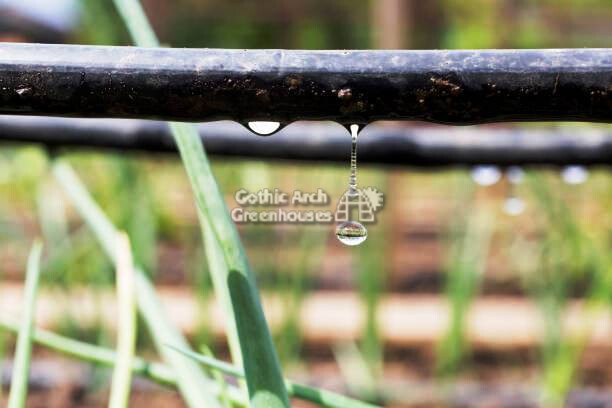 Ensuring your plants get enough water and nutrients is an essential part of greenhouse production. Multiple irrigation systems are available, ranging from simple, such as watering by hand, to more sophisticated computer-based irrigation control systems.
Ensuring your plants get enough water and nutrients is an essential part of greenhouse production. Multiple irrigation systems are available, ranging from simple, such as watering by hand, to more sophisticated computer-based irrigation control systems.
This article will more closely examine the benefits of drip irrigation and flood irrigation systems for greenhouses.
Drip Irrigation Systems
In drip irrigation systems, water travels through a system of tubing, pipes and valves and is released as a steady “drip” of moisture near the base of the plant. This type of system localizes the watering and fertilization process and delivers the precise amount of water and nutrients to the plant. These are some of the many advantages of drip irrigation systems.
Advantages of Drip Irrigation Systems
Efficient Water Use
The precise delivery of water in a drip irrigation system prevents water waste. As a result, these systems use up to 50 percent less water than traditional watering methods, such as sprinklers, according to multiple studies.
Lower Disease Risk
Drip irrigation systems keep foliage dry, which reduces damp conditions that are a breeding ground for disease and harmful powdery mildew.
Fewer pests
Like disease, bugs love wet foliage. Because a drip irrigation system directs all water into the soil, pests can’t get to it, which creates an environment where they don’t feel welcome and thrive.
Discourages Weeds
Along with reducing disease and warding off pests, localized watering helps discourage the growth of weeds as well. Since water is placed in a specific area around the plant, weed seeds don’t get nourished and are starved.
Better Plant Health
When plants receive water uniformly, they can thrive! Drip irrigation systems space out and extend the watering period and water gets well into the root zone, which helps improve growth and results in better plant health.
Saves Time
Drip irrigation systems eliminate the need to move sprinklers or hoses around to make sure everything gets watered. Some kits make it possible to install timers so watering is automatic.
Flood Irrigation Systems
Flood irrigation is one of the earliest forms of watering crops. Several different irrigation styles make it possible to utilize this technique in a greenhouse, including capillary mats, troughs, flood and drain trays, and flood floors. These sub-irrigation options allow watering to happen from the bottom up, and they are generally considered to be more effective and efficient than systems that water from the top down. Here are some of their advantages.
Advantages of Flood Irrigation Systems
Saves Time
Some flood irrigation systems incorporate existing benches to reduce cost and save time on their setup and operation.
Uniform Plant Growth
Plants can thrive in sub-irrigation systems because each one gets the same amount of water, resulting in uniform plant growth. Flood floors are popular with larger growers for this reason.
Efficient Water Use
Delivering water from the ground up, flood irrigation systems stays in the water rather than evaporating into the air. Like drip systems, sub-irrigation methods can save 50 percent or more water.
Less Fertilizer Use
Sub-irrigation systems use water and fertilizer more efficiently. Up to 50 percent less fertilizer can be used in these systems because water is collected, stored and reused.
Lower Humidity
Supplying water from the bottom up reduces water evaporation, which means less humidity. Therefore, you have one less thing to monitor in your greenhouse!
Lower Disease Risk
This system stores and re-circulates water so little water moves between containers, trays, or troughs. This helps lower the spread of disease in your greenhouse.
Increased Space Efficiency
Placing trays and troughs throughout your greenhouse allows your plants to grow and thrive. Easy to move trays and troughs allow you to place the containers where you need them.
Which system is right for you? Let our knowledgeable professionals know if you have questions. Call us at 800-531-4769, and we’ll be happy to help you with your irrigation needs!
